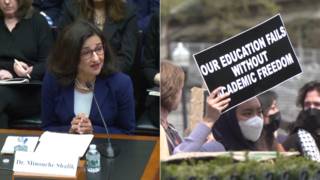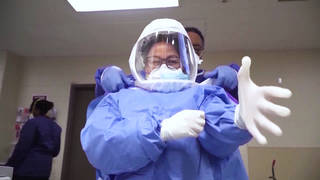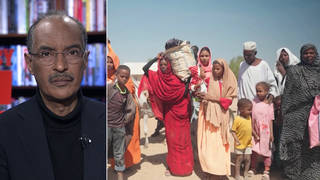
Related
Guests
- Dr. Ashish Jhaprofessor of global health and the director of Harvard University’s Global Health Institute.
President Trump claimed Monday he’s been taking the antimalarial drug hydroxychloroquine, even though multiple studies show the drug can be dangerous and is not an effective treatment for COVID-19. This comes as the U.S. COVID-19 death count tops 90,000 and all 50 U.S. states prepare to partially reopen by Memorial Day. We speak with Dr. Ashish Jha, the director of Harvard University’s Global Health Institute, who says that testing needs to vastly improve in order for widespread reopenings. He calls the lack of accurate tests in the U.S. the nation’s “Achilles heel,” saying, “The testing saga will go down as one of the big fiascos that led to us being where we are today.”
Transcript
AMY GOODMAN: This is Democracy Now!, democracynow.org, The Quarantine Report. I’m Amy Goodman, here in New York City. Juan González is joining us from his home in New Jersey. As the COVID-19 death toll tops 90,000 in the United States, President Trump claimed Monday he’s been taking the antimalarial drug hydroxychloroquine, even though multiple studies show the drug can be dangerous, is not effective in treating COVID-19.
PRESIDENT DONALD TRUMP: Good things have come out about the hydroxy. A lot of good things have come out. And you’d be surprised at how many people are taking it, especially the frontline workers, before you catch it. The frontline workers, many, many are taking it. I happen to be taking it. I happen to be taking it.
REPORTER 1: Hydroxychloroquine?
PRESIDENT DONALD TRUMP: I’m taking it, hydroxychloroquine.
REPORTER 2: Right now?
REPORTER 3: When?
PRESIDENT DONALD TRUMP: Right now, yeah.
REPORTER 3: Yeah, when?
PRESIDENT DONALD TRUMP: Couple of weeks ago, started taking it.
REPORTER 4: Why, sir?
PRESIDENT DONALD TRUMP: Because I think it’s good. I’ve heard a lot of good stories. And if it’s not good, I’ll tell you right: I’m not going to get hurt by it.
AMY GOODMAN: The Food and Drug Administration issued a warning about self-medicating with hydroxychloroquine last month, following Trump’s repeated remarks touting its effectiveness.
President Trump’s announcement came as he ramped up attacks on the World Health Organization, threatening Monday to pull out of the international organization entirely and permanently freeze U.S. funding over its, quote, “failed response to the COVID-19 outbreak.
The U.S. has less than 5% of the world’s population but almost a third of the confirmed COVID-19 infections worldwide. Despite these numbers and a quarter of the worldwide deaths in the United States, all 50 states will at least partially reopen by Memorial Day weekend, even as infection rates in many states continue to rise. Only 16 states are currently seeing downward trends in cases, according to Johns Hopkins University.
Well, for more, we’re going to Cambridge, Massachusetts, where we’re joined by Dr. Ashish Jha, the director of Harvard University’s Global Health Institute, a professor of global health at the Harvard School of Public Health.
We welcome you, Doctor, to Democracy Now! Let’s begin with this, I guess, bombshell that Trump dropped yesterday, because the impact it has all over the country, not possibly just on his own health, when he said that he started about a week and half ago, presumably after his personal aide, valet, tested positive for COVID-19 — he said he’s now taking hydroxychloroquine. Now, this flies in the face of the latest studies. If you can tell us what they are and what you thought when you first heard this?
DR. ASHISH JHA: Yeah. So, thanks for having me on. I was — I have to tell you, I was pretty surprised. If I was his personal physician, I would not have recommended it. I would have actually recommended very strongly against it. There is no evidence, that I’m aware of, that hydroxychloroquine is helpful in preventing getting coronavirus, COVID, if you’ve been exposed. And we know that it does have toxicities. Almost every medicines have some toxicities. And while hydroxychloroquine is reasonably safe under close medical supervision, it still has real side effects. And I just — I think the risk-benefit here is all wrong for the president. And I personally don’t think he should be taking this medicine.
AMY GOODMAN: And the effect this has on people? There will be a rush on hydroxychloroquine, of course, if the president is taking it, or requests of doctors to give it. And also, isn’t it simply a message? Like we see with his approach to climate change and the climate crisis, it’s just this anti-science slap.
DR. ASHISH JHA: Yeah. So, we want our leaders to model good behavior, right? And part of that is that we do have a scientific approach to coronavirus. We do have one therapy now that looks like it’s going to work. That’s remdesivir, though that’s right now really only for sick people in the hospital. And when the president really kind of goes off where the scientific consensus is and starts doing things on his own that are really against the scientific consensus, I think it is harmful. And I think what happens is a lot of people decide, “Well, he must know something that others don’t,” and will try to emulate that, and that will end up being harmful for those people’s health, as well.
JUAN GONZÁLEZ: And, Dr. Jha, I wanted to ask you this. These contradictions here of, on the one hand, federal health officials saying one thing to the general public, allowing individual states to develop their own policies, while, on the other hand, the president, as a lone ranger, occasionally either contradicting the states or contradicting his own federal health officials, what this does to the ability of the country to develop a systematic plan to confront the coronavirus?
DR. ASHISH JHA: Yeah, this has been one of the biggest challenges in this outbreak. You know, the federal leadership has really been lacking. And at times it’s been — the federal approach has been downright harmful. So, for instance, they came up with a plan for how states can open safely. It was called “Open Up America Again.” And it was pretty good. I mean, there were parts of it I disagreed with, but it was generally in the right direction. And then the president has spent the last couple of weeks essentially undermining his own plan. And that creates an incredible amount of confusion in states, who don’t know: Should they be listening to his plan, or should they be listening to his tweets? And that’s a — there shouldn’t be any separation between the two. And it’s very confusing, and that has left a lot of states to try to sort all this out on their own without any federal guidance, and, in fact, at times, contradictory federal guidance.
JUAN GONZÁLEZ: And what about what the states are pursuing? About 48 states now are partially reopening this week. Fifty will have partially reopened by Memorial Day. What is your sense, especially given the fact that several of these states are still seeing upticks in the number of cases?
DR. ASHISH JHA: Yeah. So, if we go back to that initial guidance that I mentioned, which I thought was generally right, you know, the main principles were you should see declining cases for 14 days or very, very low number of cases, and you should have adequate testing and tracing capacity. Very few states meet all of those.
And my general feeling is, I get that people are kind of antsy to get back to work, to the extent possible. Obviously, for a lot of poor people, this has been an extraordinarily difficult financial hardship, as hourly wage workers, others.
So, what we really need is a very careful, very slow plan. And, you know, some states, I think, are being responsible. Other states, where cases are still rising and yet they’re opening up bars, that worries me immensely about what’s going to happen there, in terms of both spike in cases and eventually maybe having to shut down again because their outbreak gets out of control.
AMY GOODMAN: So, Dr. Jha, can you talk about the significance of testing, this critical issue? President Trump stood in the Rose Garden against a banner that said the U.S. leads the world in testing, when, in fact, when President Trump started to begin to hear about the pandemic, you know, the intelligence agencies, his own heads of agencies saying you have to move, as late as — as early as January, even December — what he keeps touting is he pushed this Chinese travel ban. But if he thought it was that significant at that time to push the ban, this issue of immediately ramping up testing and getting PPE, personal protective equipment, to people all over this country — first and foremost, healthcare workers, of course.
Start off by talking about what happened with testing at the beginning. You’re very critical of the CDC. But also, what it means even today, the fact that here in New York City, if you are not symptomatic but you want to get a test — and we know that more than half of people that are infecting others are not symptomatic — you cannot get a test, unless you have some special connection, even though President Trump insists that that’s not true?
DR. ASHISH JHA: Yeah. So, the testing saga will go down as sort of one of the big fiascos that led to us being where we are today. There’s no question in my mind that this has really been one of the Achilles heels of our entire response.
So, the saga really begins in later part of January, when the World Health Organization offered up a test kit that was developed by a German virologist, and it was available to countries around the world, including the United States. The U.S. decided not to use the WHO test kit. Now, that’s not a totally unreasonable decision. The CDC — it was a premier public health agency — has a lot of experience building its own tests, so it built its own test. OK, that’s reasonable. It’s fine. Problem was that test failed. It got contaminated, and it didn’t work. And weeks and weeks and weeks went by. And private labs —
AMY GOODMAN: [inaudible] use the World Health Organization test, which was proven, which worked. It was there.
DR. ASHISH JHA: It was there. And what should have happened is, at the moment that CDC realized its test failed, it should have gone back and gotten the WHO test kit and started using that while it was fixing its own. But instead, we wasted all of the rest of January, all of February, into early March. We prevented private labs from making tests, and we didn’t really build one ourselves in the public sector. And so we found ourselves in March with a large outbreak and no real testing capacity.
And that was, in my mind, the main reason we had to shut our economy down, is because we just could not figure out who was infected and who was not, and the best way to stop exponential growth at that point is to have everybody shelter in place. But that’s a very costly way to slow down a viral outbreak. But you have to do it if you don’t have a good testing infrastructure.
JUAN GONZÁLEZ: But, Dr. Jha, now we have various types of tests that have been produced, and some of them with disturbingly high percentages of false negatives. What about the quality control now, that should be the federal government’s responsibility in terms of determining what’s the best test to use?
DR. ASHISH JHA: Yeah. So, what’s really important for your viewers and listeners to know is that there are two types of tests and two broad categories of tests. There’s antibody testing and then testing for the virus. And testing for the virus is mainly what we’ve been talking about so far. We can talk about antibody testing, which is another important but unrelated issue.
On the testing for the virus, the primary approaches we have do have a false negative rate. They vary from 10 to 30%. And some of that is a quality control issue, but some of it is just the reality of the virus that we’re trying to test for. It may be early in the disease course. You may not have enough virus. You may not get a good sample. And that’s why you often actually need to be testing people more than once, if they have what looks like coronavirus but test negative. I really do think that on the issue of that, the problem has been we’ve been too slow to develop new technologies.
On antibody testing, it’s been a mess in terms of quality control. That’s where the quality control problems have been really rampant. But on the virus testing, it’s been primarily an issue of just not being able to ramp up and do enough of these tests. There are some quality control problems, but, to me, that’s not — hasn’t been the biggest concern on the virus testing.
JUAN GONZÁLEZ: I wanted to ask you — at the international level, there are great disparities between where COVID-19 is spreading in countries around the world. For instance, I mean, the startling situation of the island of Hispaniola, where, in the Dominican Republic, there are more than 7,600 confirmed cases, but right across the border on the same island, in Haiti, it’s about only 85. Do you think that there are any genetic issues in terms of which populations are more disposed to being affected by COVID-19?
DR. ASHISH JHA: Yeah. So, you know, one way to think about this is, we are early in this pandemic. The way I’ve sort of often described it, using a baseball analogy, is that we’re probably in the top of the third inning of a nine-inning baseball game, meaning that we have a long way to go. And in the early days, you’re going to see a lot of variations in who’s been infected, where the disease has spread. It’s going to be driven in large part by things like travel, where did the virus first show up. There’s a certain amount of idiosyncratic features.
I am not convinced — I haven’t seen any data that any group of humans are more susceptible than others in terms of populations. Obviously, older people are more susceptible. But I mean, you know, are Haitians more or less susceptible than Dominicans? Are Indians more or less susceptible than Chinese? I don’t see any data out there that makes me think that’s a major factor.
I think social structure, I think resources, I think travel — all those other things are much bigger determinants of where we’re seeing the outbreaks so far. But six months from now, the picture may look very, very different. And so, we just have to remember that we’re still early.
AMY GOODMAN: What about Africa? I mean, we don’t see large numbers in Africa. Is that because of lack of testing? I mean, South Africa is dealing with this. Kenya is dealing with this, of course. And Kenya has just shut down its borders to Somalia and Tanzania. But is it because it’s a much younger population, or the other issues you just mentioned?
DR. ASHISH JHA: Yeah. So, Africa, the entire African continent, has been interesting. It has done better so far than I was expecting, just to be very frank. I was deeply worried. I still remain worried. And I remain worried because, again, it is still early days, but so far they have done better than I was worried they might.
And so, the questions are why. One is, certainly it is possible that, you know, you have a younger population, and so, even if they’re getting infected; maybe the lack of robust testing; maybe the lack of a very substantial surveillance system; maybe missing a lot of cases. I think that’s possible. There may be some seasonality issues. There is reason to believe that warmer, more humid temperatures lead to lower levels of transmission. That might be playing a factor. There’s a variety of kind of theories out there.
I hope, obviously, that the entire continent ends up being spared. I will tell you that I worry that as time goes on we’re going to see more and more outbreaks across the African continent. Obviously, lots of variation across the continent, but I worry a lot about that. And I always hope that I’m wrong on that. So, we’ll see how that plays out, but we’re still early days.
JUAN GONZÁLEZ: And I wanted to ask you about the vaccine situation. Of course, we saw the news yesterday about Moderna’s vaccine showing some promise, and of course the stock market immediately having a major rally as a result. What is your assessment of how long it will take to produce a vaccine, and, of course, then the issue of mass producing it in sufficient numbers for the entire planet?
DR. ASHISH JHA: Yeah, it’s a great question. So, you know, among public health people, I tend to be on the optimistic side. So you should know that, because what I’m going to tell you, obviously, my views, is a bit more optimistic than I think where most public health people are. But that said, let me give you my views on this.
I am pretty optimistic we’re going to have a vaccine. I am very optimistic that that vaccine will come in 2021. It’s very, very hard for me to see a vaccine being safe, effective and widely available in 2020. I just — I can’t quite figure out how that would happen. Obviously, again, love to be wrong, but I think sometime in 2021, and I’m guessing probably mid-2021 is my best guess.
Now let’s talk about where we are on vaccines. There are over a hundred different efforts to build a vaccine. There are eight that are in clinical trials, and a few of them are moving along very nicely. There’s Moderna. There’s the Oxford one. There’s one in — actually, two in China that are both also potentially promising. There are others in Europe. So, there’s a lot of activity here. I have no idea which of these vaccines will play out and when, right? I have no idea which one will turn out to be safe or effective. Any of them could. It could be that we have five or six vaccines that work. I don’t know, but I am very confident that one of them will.
And one of the reasons I’m so confident is that we have been able to show that we really can induce immunity to this virus. We know that people clear the virus. They get a pretty robust immune response. And so, scientifically, believing that we’re going to have a vaccine in 2021, I think, is a pretty fair assumption.
Now, the other question of — OK, you have a vaccine, let’s say. You know, you do the testing. It’s safe. It’s effective. How do we make sure everybody gets it? And that is going to be a massive challenge. And there’s a huge set of production issues. There’s a huge set of distribution issues, equity issues. I think it’s incredibly important that people in India get it, people in Kenya get it, people in the United States get it, people in China get it. And that is going to require a certain amount of global coordination. It’s going to require a certain amount of global solidarity. And I worry a little bit about kind of where we are heading — certainly our political leadership, but other political leaders, too — in terms of that movement towards global solidarity.
AMY GOODMAN: [inaudible] to Moderna’s chief medical officer, Dr. Tal Zaks.
DR. TAL ZAKS: We can indeed, with this vaccine, induce an immune response in everybody that received the vaccine, and that immune response generates the kind of antibodies that one would hope to generate, antibodies that can neutralize the virus, and that we can get to the levels of antibodies that are those seen in people who have been infected with SARS-CoV-2, or, in fact, even exceed those levels.
AMY GOODMAN: So, I wanted to go to this issue, this test that was done by Moderna that everyone is holding out such hope in, although you talk about a bunch of others, Dr. Jha. This was just done on eight people, right? It’s in the first phase of the trial. And it showed that they produced antibodies. And then explain — and safety, that it didn’t kill them. The shot didn’t kill them. Explain what then has to happen, how this ramps up, because President Trump so quickly just throws out things, and it’s hard to put them in a kind of scientific context to understand what we should take seriously. And then, your most critical point, like Jonas Salk with the polio vaccine, how it’s made free for all?
DR. ASHISH JHA: Yeah. So, basically, what I would say to folks is, you’re going to see a lot of sensational headlines in the upcoming days, weeks and months, because we’re all paying attention, and we’re all hoping. And I generally think it’s important to listen to scientists, and less to politicians, and especially when politicians really go off and start saying things that are not science-based.
In terms of where the Moderna vaccine is, again, eight people, phase one, early days, right? But encouraging early days. Like, the effect that those eight people developed a level of immune response that we’ve seen with people who have cleared the infection, the fact that their antibodies were neutralizing — could neutralize the virus, that all is very, very encouraging.
Now, there is a lot between here and having that vaccine be produced safely and effectively for hundreds of millions or billions of people. There are many, many steps along the way. We’ve got to give it to a much larger group of folks. We’ve got to make sure that — you know, imagine if the vaccine kills one in 500 people, which would be an incredibly bad outcome — I’m not saying it does, by the way. It’s been shown to be very safe. You’re not going to pick that up in small studies. You need to study it in large enough people to identify untoward effects. So, we’ve got to do that. We’ve got to do that, and then we really have to make sure that those neutralizing antibodies do protect people.
And we’re going to have to think about how do we test that, not in a laboratory, but actually — I mean, are we going to expose people to live virus? There are people who have suggested that. Are we going to give it to healthcare workers who are on the frontlines, and then look to see if any of them get infected?
There’s a lot of work ahead, because if we don’t build a vaccine that’s safe and effective, but certainly safe, people aren’t going to want to take it. And so, that is really an incredibly important part of this, moving forward. And then, of course, there is a ramp-up of how do you then produce billions of doses of the vaccine in a way that, again, people are going to feel confident — healthy people are going to feel confident giving it to their kids, giving it to themselves, giving to their parents. Those are going to be really important issues.
AMY GOODMAN: Very quick —
DR. ASHISH JHA: Again, I have no — I think we can get there, sorry, but it’s going to be work. Please.
AMY GOODMAN: Very quickly, you’re talking to us from Harvard, one of many schools in this country. It has more chance of surviving than a number of other schools if they don’t reopen. But can you talk about the decisions? You have places like Northeastern, that’s saying, “We’re open, starting in the fall.” You have places like Notre Dame that are saying, “We’re going to open early and then end by Thanksgiving,” also University of Alabama, “because we expect there to be a surge in December, and so we want the kids out by Thanksgiving, and then they won’t come back for a while.” Can you talk about the decision? And not only colleges, of course, high schools, elementary schools. What must go into this decision? And what do you think should happen?
DR. ASHISH JHA: Yeah. As you might imagine, this is not just a conversation I’m having with lots of public health people and education officials, but also at home with the kids about what’s going to happen in the fall.
The way I think about this is there’s going — what is likely to happen is a lot of variations. Some schools are going to open, some schools are going to stay online. What should drive the decision-making? Well, one is how much community transmission is happening in that place at that time. So, if we’re thinking about Harvard University, for instance, how much community transmission is happening in eastern Massachusetts? If a lot of people are getting infected and sick, it’s going to be very hard for Harvard or any university in eastern Massachusetts to open.
Second is around availability of testing. I think you have to have a strategy where you’re going to have to be able to test kids and staff and faculty on an ongoing basis.
Third is you’re going to have to do certain social distancing things. There are going to be no large classes. There should be no large classes. There should be — if you’re going to do sporting events, certainly not with any kind of spectators, and you have to really think about what sporting events can you justify and how do you do that.
So there’s a lot of changes that are going to need to happen. I like the idea of starting early and trying to end early. I think most of us believe there will be a surge of cases in the fall. All the principles I just laid out need to happen for primary and secondary schools, as well, really rethinking things like cafeteria, rethinking things like sports. And if we do all of that, I believe there’s a very, very good chance that we can open up schools, we can get kids back to school in the fall. It may not look like a normal fall, but if we can get through this fall and we have a vaccine early in 2021, we can get through this pandemic.
AMY GOODMAN: Well, Dr. Ashish Jha, we want to thank you so much for being with us, professor of global health and director of Harvard University’s Global Health Institute.
When we come back, can local journalism survive the pandemic? Tens of thousands of journalists have lost their jobs, been furloughed or received pay cuts as newsrooms continue to shrink or shutter. Stay with us.












Media Options